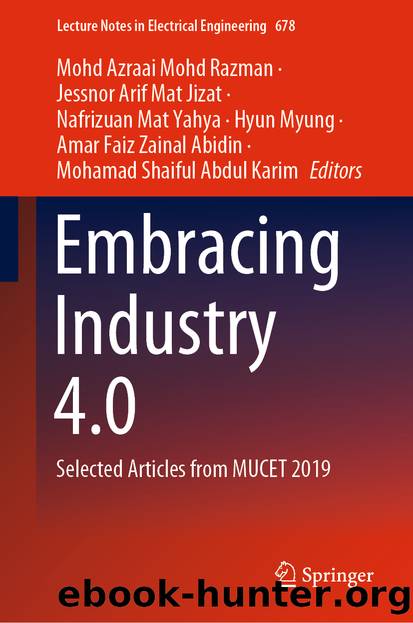Embracing Industry 4.0 by Unknown

Author:Unknown
Language: eng
Format: epub
ISBN: 9789811560255
Publisher: Springer Singapore
1 Introduction
In modern distribution network, relays configuration supposedly to be arranged properly to ensure the reliability of the system’s designed. Good configuration will remove the affected portion whereas keep the supply to the healthy portion during fault occurrences. Every equipment will be protected by two layer of relays which known as main relay and secondary relay. Main relays will react to the abnormal current flow within permitted time. If the main relay is fails to function well, secondary relays should take over the operation. Nevertheless, once the backup relay has taken over on behalf of the primary relay, the unnecessary power outages to a bigger portion of the system will occurs. This is why well-coordinated of the overcurrent relays is essential.
The optimization of the overcurrent relays (OCR) discrimination is establishing by two parameters that know as Plug Setting (PS) and Time Multiplier Setting (TMS). The OCR coordination is formulated as inequality constraints. In 1980s, The experimental of Trial and Error algorithm [1] has been wisely implemented to perform the OCR discrimination work. However, this approach only suitable for small distribution scale network. In early late 1980s researches has moved to topological analysis method which uses the graph theory approach to determine break points [2]. Whereas, in late 1990s, Linear Programming (LP) approach was presented in the frame of optimization method [3–6]. However, the slow convergence rate is the main drawback for the conventional methods especially for the system with large iteration no.
In early 2000, Genetic Algorithm (GA) [7–10] has pioneered the optimization method to resolve the OCR issue. GA known as the most popular method during that days. Then modification has been made to the original GA to improve the computational time of the method that called Continuous Genetic Algorithm (CGA) [11]. The evolutionary of the nature inspired approach is then continued with Particle Swarm Optimization [12–14] method which demonstrated to offer promising result rather than original GA and modified GA. The modernization of the technique is resumed by Cuckoo Search Algorithm [15]. In addition, hybrid method has been introduced in [16–19] to enhance the capabilities of the approaches. In overall, the approaches are established to explore the optimal OCR setting.
The No Lunch Free (NFL) theorem [20] highlighted that none of the method are able to solve all the problems. Since there are no limits in approaching for a new algorithm, this paper is proposing two new algorithms that known as Ant Lion Optimizer (ALO) and Grey Wolf Optimizer (GWO). Both algorithms are new for the OCR coordination field. The algorithm will be applied to search for the optimize value of the parameters TDS and Ip. The optimized parameters’ value will have determined the minimize value of the objective function. From this comparative study, the best method shall be established with regards to solve the OCR coordination issue.
This research is constructed as follows; Firstly, problem formulation explained at Sect. 2. Next section explained on the background of GWO and ALO. The paper is resumed with Sect. 4 which analyzed the simulation results.
Download
This site does not store any files on its server. We only index and link to content provided by other sites. Please contact the content providers to delete copyright contents if any and email us, we'll remove relevant links or contents immediately.
Cecilia; Or, Memoirs of an Heiress — Volume 3 by Fanny Burney(30934)
Cecilia; Or, Memoirs of an Heiress — Volume 2 by Fanny Burney(30889)
Fanny Burney by Claire Harman(25784)
We're Going to Need More Wine by Gabrielle Union(18073)
Plagued by Fire by Paul Hendrickson(16637)
Cat's cradle by Kurt Vonnegut(13867)
Bombshells: Glamour Girls of a Lifetime by Sullivan Steve(13108)
All the Missing Girls by Megan Miranda(12748)
Leonardo da Vinci by Walter Isaacson(11903)
4 3 2 1: A Novel by Paul Auster(11049)
Adultolescence by Gabbie Hanna(8145)
The remains of the day by Kazuo Ishiguro(7551)
Note to Self by Connor Franta(7024)
Diary of a Player by Brad Paisley(6866)
Giovanni's Room by James Baldwin(5878)
What Does This Button Do? by Bruce Dickinson(5527)
Recovery by Russell Brand(4565)
Born a Crime by Trevor Noah(4511)
The Kite Runner by Khaled Hosseini(4435)
